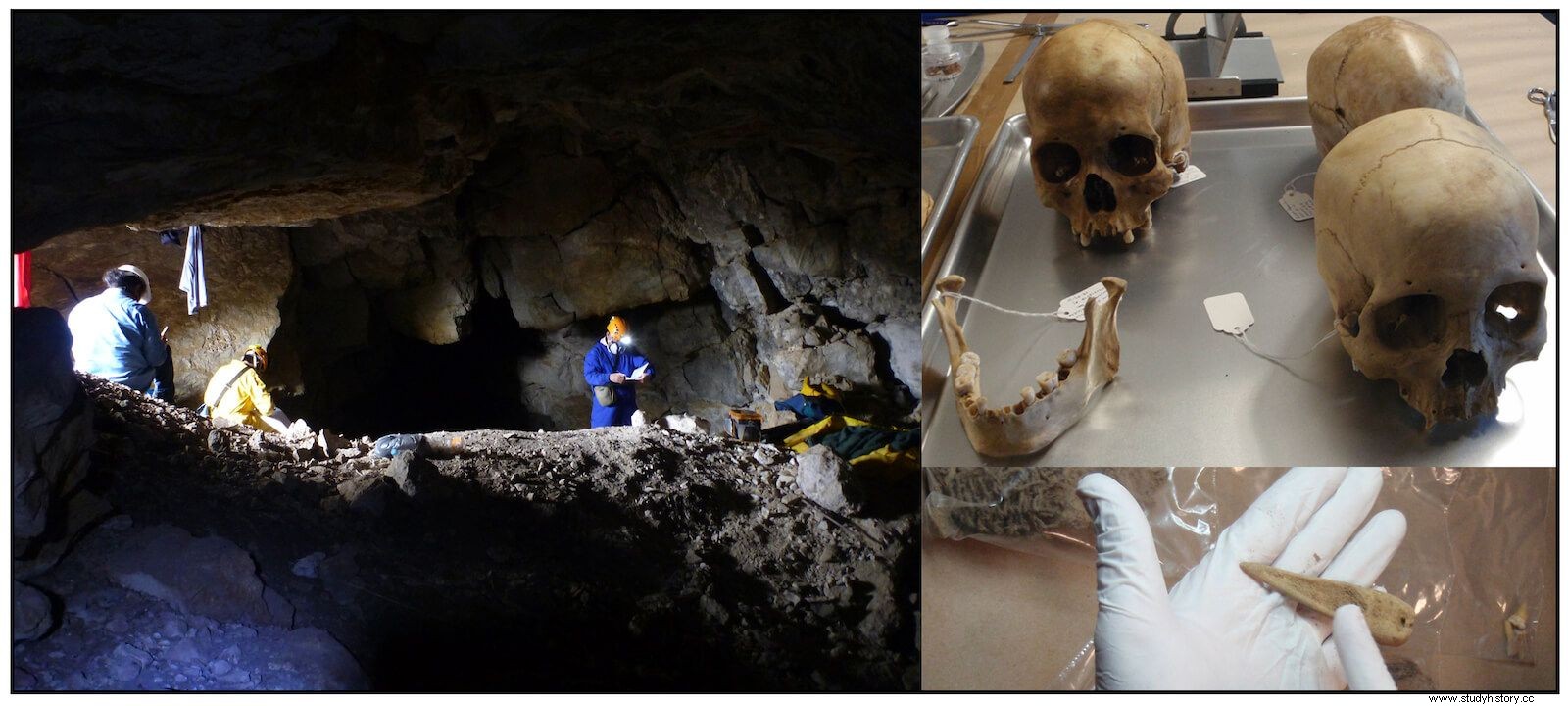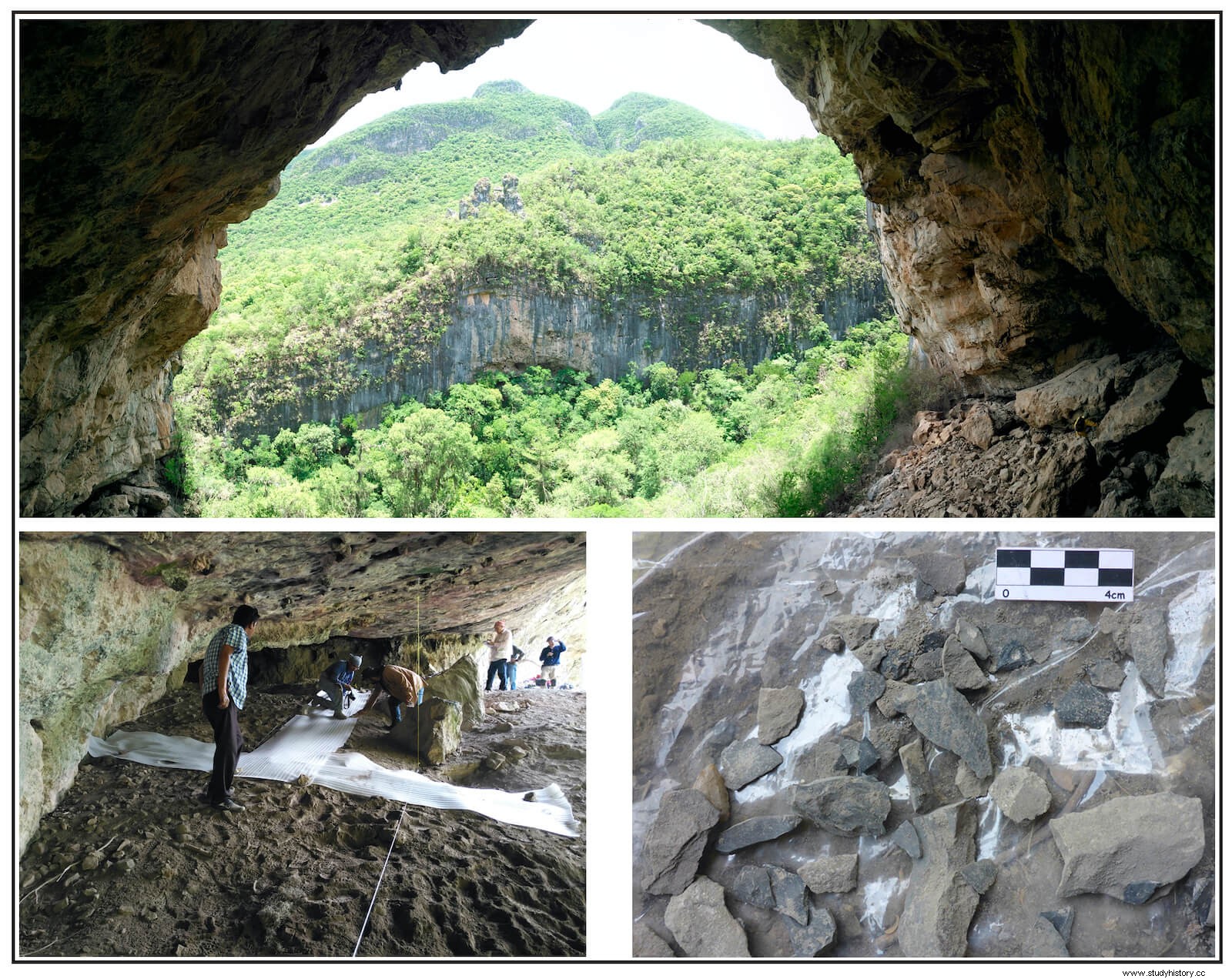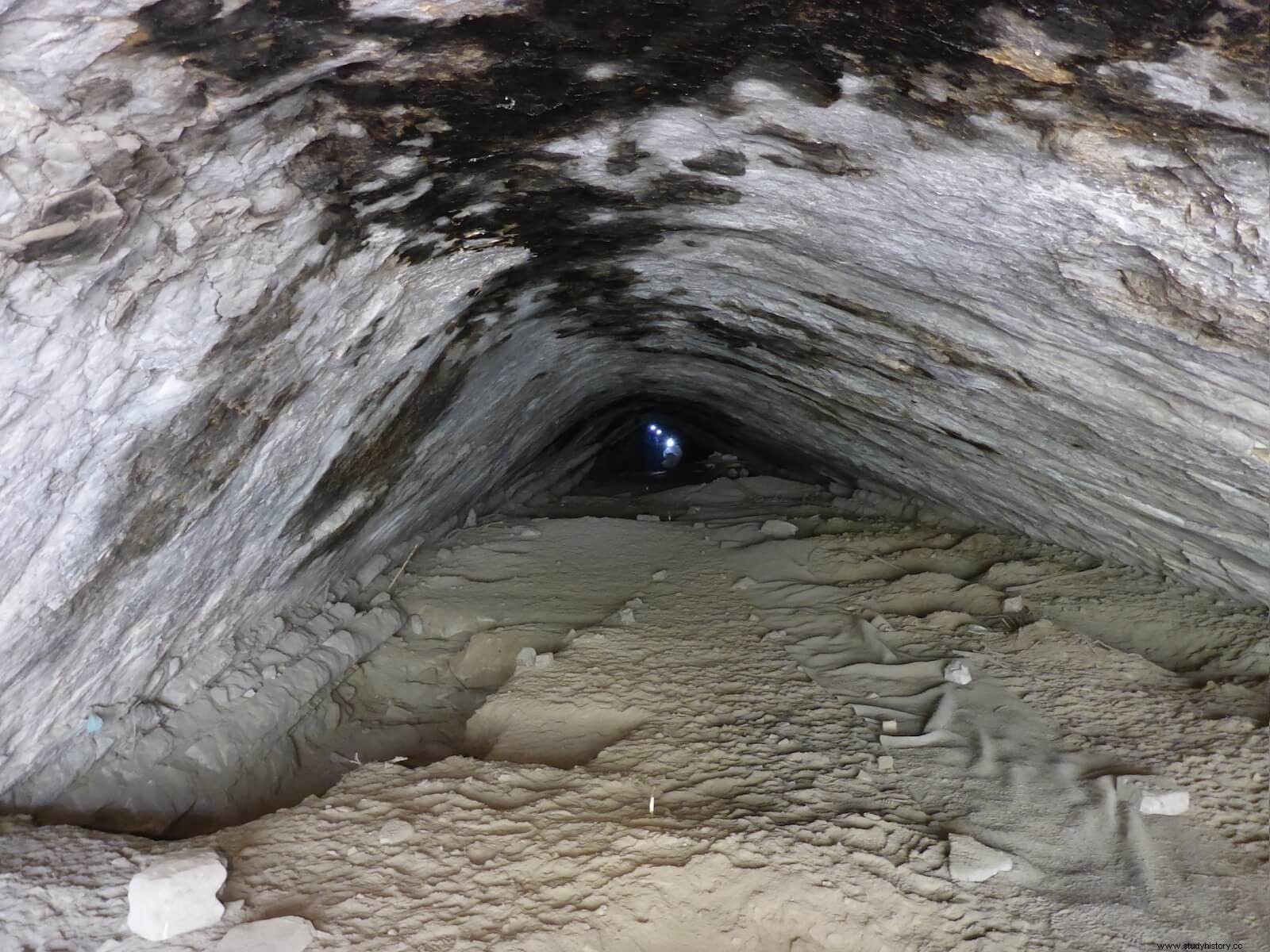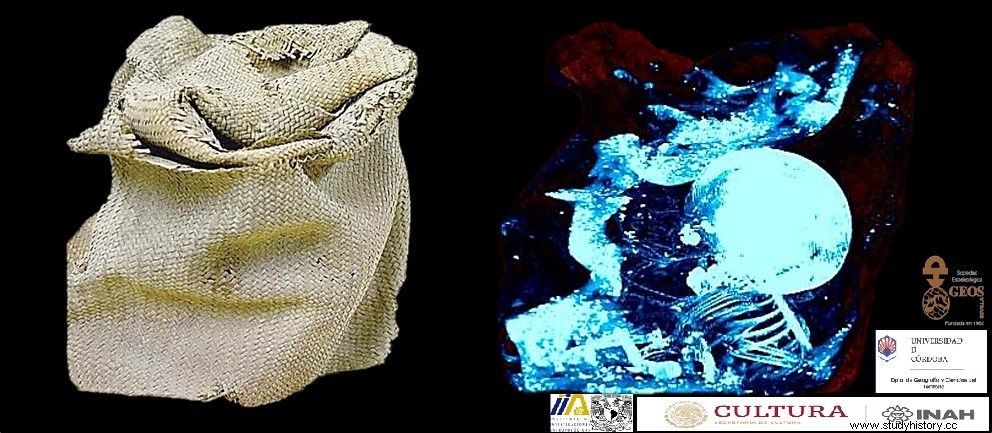
The results and experiences of these investigations have served as starting point for the implementation of an investigation (CumoT project ) aimed at the chronological and biocultural characterization of human remains and materials from mortuary caves in the state of Tamaulipas , applying specific techniques and methods with the intention of establishing the possible interaction of the indigenous groups settled in this region, and their relationship with the natural environment. A region in which we find characteristic elements of the pre-ceramic, hunter-gatherer societies, which occupied caves and shelters; as well as agricultural producing economy groups.
For this, a working group and international multidisciplinary collaboration have been set up in which scientists from Spanish institutions and organizations (University of Córdoba, University of Seville, Geos Speleological Society, etc.) and Mexicans (INAH and UNAM) participate. Its execution has been possible thanks to the sponsorship of the Ministry of Culture (year 2012), the PALARQ Foundation (from 2017 to 2019), the CEI Cultural and Natural Heritage Project (Universities of Andalusia), the National Institute of Anthropology and History, the University National Autonomous University of Mexico, as well as the Government of the State of Tamaulipas through the Autonomous University of Tamaulipas and the Parks and Biodiversity Commission in agreement with the S.E. Geos (2018 and 2019).
The multidisciplinary nature of the research allows not only the investigation into historical-cultural processes, but also focuses on the study and assessment of the natural physical and biological environment of the cavities where man carried out his activities . For this reason, part of the specific objectives are aimed at geological, biogeographical, biospeleological, bioarchaeometric studies and any other aspect that conforms to the integral nature of the site, such as its state of condition and possible corrective measures. All this without forgetting its impact on the human communities that currently inhabit the area, as an essential element in the transfer of knowledge to society.
The research, which takes place in the state of Tamaulipas, covers a wide area in which we can distinguish three different geographical focuses. On the one hand, the surroundings of the Sierra de Naola, near the city of Tula; on the other hand, the mountainous area near the state capital, Ciudad Victoria; both in the Sierra Madre Oriental. And, finally, a third sector, in the Sierra de Tamaulipas.

The work carried out has made it possible to locate numerous sites with cavities, shelters and cellars (chasms), in a work of exterior prospecting and underground exploration a, almost always, in very complicated conditions, in which the intervention of people from the environment has usually been necessary as guides or for various logistical tasks.
For the underground area, the installation of topographical stations, which have served as a basis for taking measurements, as well as taking photographs and drawings, have made it possible to draw up plans in which the plans, developed elevation and sections of the most representative points are collected, which has facilitated a record and a systematic and rigorous archaeological survey . The results obtained are reflected in the finding of numerous archaeological materials that inform us of a continued frequentation of the caves by indigenous groups. Fundamentally, these are lithic and ceramic industries, but also other typologies (decorations, construction materials, funerary elements, etc.) that would be the result of a wide range of activities.
The mortuary caves of Tamaulipas
In places like the Cueva de la Sepultura (Tula) different stratigraphic profiles and plants from archaeological levels were documented, recovering an interesting collection of human skeleton remains, as well as other types of materials. Among them, the fragments of wooden sticks of different sizes stand out, some with remains of cordage, textile fragments and basketry that, in general, are associated with the manufacture of funerary bundles or other container elements intended for different daily tasks. Anthropological studies indicate that the human remains would belong to indigenous population groups with a dolichoid cranial morphology characteristic of the typical ancient populations of Aridoamerica that would have used the cave as a funerary enclosure. The chronological results (C14) carried out indicate that the numerous bone remains, as well as fragments of textiles, basketry and cordage, should be associated with moments more than 3000 years ago.
In this same area the Cueva de Las Calaveras was studied , in which a complete topography and a superficial collection of archaeological remains, mostly ceramic and bone, were carried out. For the former, the preliminary study reports their similarity to materials from Mesoamerican groups in the Río Verde area, with proposed chronologies of between 1800 and 1400 years old. Likewise, there is a dating on a human tooth that offers a chronology of approximately 2600 years ago.

South of Ciudad Victoria is Hidden Cave , a site that has an extraordinary stratigraphic record indicative of a broad occupational sequence, the excavation of which has provided archaeological materials, including some mummified human burials in good condition, accompanied by numerous ceramic fragments, carved lithics, basketry elements, tools bone etc. Absolute dates show continued use of the cavity, with chronologies ranging from 4,400 years to 800 years before now. Until now, the characterization of ceramic materials locates populations from the early phases of the development of sedentary groups in the Sierra Madre Oriental, that is, between the Mesa del Guaje phase (between 3400 and 2400 years ago) and La Florida (between 2400 and 2400 years ago). and 1800 years). On the other hand, the recovered projectile points, made with local raw materials, can be clearly related to the Abasolo Complex, since there is a substantial similarity between them and the Catán type points. with a rounded base and Matamoros triangular in shape, diagnostic artifacts of said hunter-gatherer complex from the Abasolo period.
Another of the highlights is the Anniversary Coat , northwest of Ciudad Victoria, where a rescue was carried out in 2019 that showed the great potential for archaeological research it has. 19 surface collection units were established and an excavation unit was traced in the most affected area. The materials collected were mainly carved lithics, polished lithics, ceramics and human and faunal bone, with ceramics having a higher incidence than the rest of the materials.
Among the surface elements, in addition to the remains of stoves, a fragment with exterior decoration formed by thick, shallow incised lines, a type rarely reported in the area, as well as others with the brushed or polished surface reddish. There are numerous carved lithic artifacts such as cores, flakes and various tools, with the notable presence of some polished (millstones, mills, etc.). Human bone remains were also recorded that are probably related to burials. Likewise, fragments of enjarre (plaster) were found that would form part of some type of wall structure. On the southwestern wall of the rock shelter there are elements of cave painting, consisting of parallel vertical straight lines in red.
The test pit was located in the central part of the shelter. Among the collapsed sediment from looting, this unit offered an important sample of lithic and ceramic artifacts, which were dated thanks to the fact that they are associated with a forceful lenticule of carbon in 870 before now. In this case, the amount of carved lithics found at greater depths was notorious, highlighting the category of tertiary and retouch flakes, which can be interpreted as an indicator of an area of activity related to the elaboration of artifacts such as projectile points, bifaces or other artifacts. In fact, three fully configured projectile points were obtained between said elements, one of which, due to its characteristics, could be related to the pre-ceramic stage of the Nogales and Repelo complexes.

As for ceramics the observed attributes allowed the identification of 8 groups. The majority group was the ceramic assemblage with a brushed surface, which can be related to the "brushed" types described by MacNeish (1958) in the Sierra de Tamaulipas and in the Sierra Madre Oriental, in the latter case in relation to the formative stage of the Little Town Complex. Other ceramic sets that stand out from the sample are those with polished surfaces and those with decoration. On the group of polished surfaces, three sets were observed; the first brown, the second red and the third with a highly polished surface. The first group seems to be a constant since this ceramic has been observed among materials from other sites in the Sierra Madre Oriental area. In a first approximation, from this preliminary study we consider that the set of materials can be the indicator of a process of cultural change related to the transition from the hunting and gathering stage to agricultural production, as well as to the process of sedentarization and the continuity of transhumance among the populations of this sector of the northeast.
Another research focus is the Sierra de Tamaulipas, where evidence of human activity has been found for more than 10,000 years , according to the interpretation of various lithic industries that would belong to hunter-gatherer societies at the end of the Pleistocene and, over the centuries, would evolve until they differentiated into agricultural villages and interconnected cities throughout the valleys, slopes and peaks of mountains, articulating one of the oldest and most complex cultural sequences in the country.
In this environment we had the opportunity to study the El Refugio cave in the municipality of Soto la Marina. Inside, fragments of wide-necked pots with partially eroded curved-divergent walls were found, generally orange, brown, reddish or black. In the Sierra de Tamaulipas, this pottery varies according to the phase in which it is found, but it is clearly identified starting about 2,600 years ago, extending until about 800 years ago, and decreasing in diversity after this period. On the other hand, on the outside near the mouth of the entrance of the cavity, the prospecting brought about the discovery of numerous lithic remains of flint where two large groups can be distinguished:a) natural nodules without carving, but with some natural breaks; b) carved lithic industry, among which flakes, cores and bifacial tools of the projectile point type can be distinguished.
In short, we present here only a small part of the results of our research, which, however, adequately illustrates the magnitude of the entire process and the great potential it presents for the future . From the CumoT project we continue to work to expand knowledge of the history of the indigenous societies of the state of Tamaulipas, their archaeological and natural heritage, where underground spaces, caves, shelters and abysses have not only played a fundamental role in their way of life, but rather represent an added heritage value for future generations.
Bibliography
- Caro, J.A.; Alvarez, G.; Camera, R. and Molina, J. (2015). “Geoarchaeology and speleology applied to the analysis and interpretation of caves with indigenous occupation in Tamaulipas (Mexico)”. Archeology and Spatial Information Technologies:an Ibero-American perspective , A. Maximiano and E. Cerrillo-Cuenca (Eds), Archaeopress 2015:209-230.
- Perez, C.; Velasco, J.E.; Moreno, A.; Caro, J.A.; Álvarez, G. and Molina, J. (ep):“Archaeology and speleology in the Sierra de Tamaulipas”. In press.
- Pérez, C. and Caro, J.A. (2022):“Elements of the Abasolo lithic complex within the Pueblito Culture in Tamaulipas. Study of projectile points from dry caves in the Sierra Madre Oriental”. In The Historical Conformation of the Northern Border of Mexico. A Critical Perspective , Vol. II, Juan Manuel Sandoval Palacios and Felipe Ignacio Echenique March (Coordinators).
- Velasco, J.E.; Silva, T.; Perez, C.; Meza, A.; Serrano, C.; Marry, I; Morales, P; Otero, F.; Cienfuegos, E.; Caro, J.A. and Alvarez, G. (ep). “Interpretations on paleo diet and mobility through stable isotopes in collagen and bioapatite; The Cave of the Sepultura (3050-2850 BC), Sierra de Naola, Tamaulipas”. American Anthropology .
